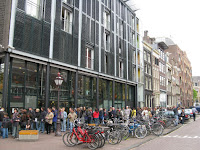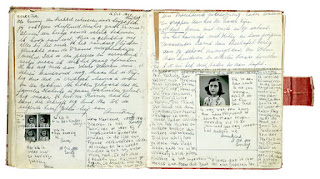l was 14 years old when I first read Anne Frank's diary. I remember being very moved by it - especially so because I was the same age that Anne had been whilst she was writing the diary, and also because she was born just 18 months after my mother, who herself lived through World War II in the English countryside as a young evacuee.
Twenty years ago I attended a conference in Rotterdam and joined a group of colleagues taking a train to Amsterdam for the afternoon in the hope of visiting Anne Frank's house and museum. However the queue was unusually long that day and we ran out of time, so I returned to Rotterdam disappointed. Nevertheless it remained etched on my mind as an important place to return to one day, and it very quickly found its way onto my sixtyat60 list.
Since the flight from Gatwick to Amsterdam takes just 45 minutes, Andrew and I decided to visit the Anne Frank museum as a day trip. We boarded the plane at 8am and by 10.30am we were in a electrically-powered taxi gliding silently and smoothly along the uncluttered streets of Amsterdam. Apart from my brief foray 20 years ago, I haven't spent any time in Amsterdam and I hadn't realised what a beautiful city it is - I was transfixed by the quirky and characterful townhouses and the tranquil canals.

Outside Anne Frank's house the queue was already stretching around the block - even in December, it seemed that people were drawn from all over the world to hear her story.

The museum told Anne's story very clearly and with great sensitivity, beginning with her birth in Germany in 1929 and her family's subsequent move to The Netherlands as their lives became increasingly threatened by anti-Semitic government policies. The next part of her story came to life as we walked through her father's offices and up the steep staircase into the secret annex where the family hid for two years. And then we heard about the family's betrayal by an unknown person and Anne's eventual death from typhus in Bergen-Belsen in March 1945, just before World War II ended.
Anne's diary was of course the lynch-pin of the museum. Anne was given her first diary on her 13th birthday, two months before the family was forced into hiding in Amsterdam. Throughout their time in the secret annex, she continued to write her diary in a number of notebooks. Many of the entries were addressed to her imaginary friend Kitty. Here's a page from her first diary below.
One of the most significant and ultimately tragic items we saw in the house was the bookcase that disguised the entrance to the secret annex - still in place 71 years after the two families were arrested and deported.
An extraordinarily poignant sight in the secret annex was the collection of picture postcards and magazine clippings of film stars that Anne had stuck on the wall in her bedroom to make it look more cheerful.
Anne's father Otto (the only survivor from the two families living together in the secret annex) was given Anne's diary after World War II ended, and having read its contents, made the difficult and courageous decision to publish it. In a 1967 interview he said, 'My conclusion is, since I had been on very good terms with Anne, that most parents don't really know their children'. I wondered whether this conclusion would be a valid one for today's parents?
Quotes from Anne's diary were displayed throughout the museum. I was struck by Anne's hopeful and optimistic view of the world, especially given the terrifying and restrictive circumstances in which she was living. Here are just a few examples:
' I keep my ideals, because in spite of everything I still believe that people are really good at heart'
'How wonderful it it that nobody need wait a single moment before starting to improve the world'
'What is done cannot be undone, but one can prevent it happening again'
'Whoever is happy will make others happy too.'
It's wonderful to think that the messages contained in Anne Frank's diary continue to be communicated across the world. Anne said in her diary 'I want to go on living even after my death'. And truly she's doing just that.
After leaving Anne Frank's House, Andrew and I didn't want to do anything else other than have a quiet wander along the canals. The sun came out and the city had a gentle buzz about it. We agreed that we must return to Amsterdam soon for a longer trip. We walked towards the station to catch our train. We reached the station and stopped for a moment in absolute amazement in front of a vast mountain of parked bikes with fine old-fashioned handlebars. Eat your heart out Boris.
In summary, it was a memorable trip to Amsterdam, which has given us loads of ideas for further trips to The Netherlands and beyond - and more importantly than that, has enabled us to pause and appreciate the fact that we have the freedom to do so.
Twenty years ago I attended a conference in Rotterdam and joined a group of colleagues taking a train to Amsterdam for the afternoon in the hope of visiting Anne Frank's house and museum. However the queue was unusually long that day and we ran out of time, so I returned to Rotterdam disappointed. Nevertheless it remained etched on my mind as an important place to return to one day, and it very quickly found its way onto my sixtyat60 list.
Since the flight from Gatwick to Amsterdam takes just 45 minutes, Andrew and I decided to visit the Anne Frank museum as a day trip. We boarded the plane at 8am and by 10.30am we were in a electrically-powered taxi gliding silently and smoothly along the uncluttered streets of Amsterdam. Apart from my brief foray 20 years ago, I haven't spent any time in Amsterdam and I hadn't realised what a beautiful city it is - I was transfixed by the quirky and characterful townhouses and the tranquil canals.

Outside Anne Frank's house the queue was already stretching around the block - even in December, it seemed that people were drawn from all over the world to hear her story.

The museum told Anne's story very clearly and with great sensitivity, beginning with her birth in Germany in 1929 and her family's subsequent move to The Netherlands as their lives became increasingly threatened by anti-Semitic government policies. The next part of her story came to life as we walked through her father's offices and up the steep staircase into the secret annex where the family hid for two years. And then we heard about the family's betrayal by an unknown person and Anne's eventual death from typhus in Bergen-Belsen in March 1945, just before World War II ended.
Anne's diary was of course the lynch-pin of the museum. Anne was given her first diary on her 13th birthday, two months before the family was forced into hiding in Amsterdam. Throughout their time in the secret annex, she continued to write her diary in a number of notebooks. Many of the entries were addressed to her imaginary friend Kitty. Here's a page from her first diary below.
One of the most significant and ultimately tragic items we saw in the house was the bookcase that disguised the entrance to the secret annex - still in place 71 years after the two families were arrested and deported.
An extraordinarily poignant sight in the secret annex was the collection of picture postcards and magazine clippings of film stars that Anne had stuck on the wall in her bedroom to make it look more cheerful.
Anne's father Otto (the only survivor from the two families living together in the secret annex) was given Anne's diary after World War II ended, and having read its contents, made the difficult and courageous decision to publish it. In a 1967 interview he said, 'My conclusion is, since I had been on very good terms with Anne, that most parents don't really know their children'. I wondered whether this conclusion would be a valid one for today's parents?
Quotes from Anne's diary were displayed throughout the museum. I was struck by Anne's hopeful and optimistic view of the world, especially given the terrifying and restrictive circumstances in which she was living. Here are just a few examples:
' I keep my ideals, because in spite of everything I still believe that people are really good at heart'
'How wonderful it it that nobody need wait a single moment before starting to improve the world'
'What is done cannot be undone, but one can prevent it happening again'
'Whoever is happy will make others happy too.'
It's wonderful to think that the messages contained in Anne Frank's diary continue to be communicated across the world. Anne said in her diary 'I want to go on living even after my death'. And truly she's doing just that.
After leaving Anne Frank's House, Andrew and I didn't want to do anything else other than have a quiet wander along the canals. The sun came out and the city had a gentle buzz about it. We agreed that we must return to Amsterdam soon for a longer trip. We walked towards the station to catch our train. We reached the station and stopped for a moment in absolute amazement in front of a vast mountain of parked bikes with fine old-fashioned handlebars. Eat your heart out Boris.
In summary, it was a memorable trip to Amsterdam, which has given us loads of ideas for further trips to The Netherlands and beyond - and more importantly than that, has enabled us to pause and appreciate the fact that we have the freedom to do so.
I'm doing the sixtyat60challenge to raise funds for Shooting Star Chase children's hospice care. For further information or to make a donation please visit my JustGiving page at https://www.justgiving.com/sixtyat60challenge/
If you would like to follow this blog click here for information on how to do so








No comments:
Post a Comment